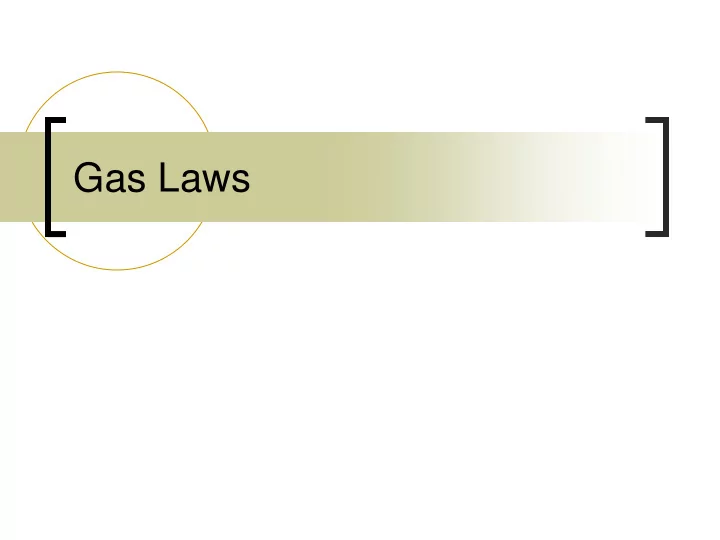

Gas Laws
Microscopic Picture Three main parameters Pressure – F/A the particles exert on the walls Temperature – measure of the average kinetic energy Volume Parameters related through an equation of state Gas Laws CEM 484 2
Ideal Gas Law Ideal Gas Law PV = nRT R - ideal gas law constant Extensive variables P,T Intensive variable V,n Molar Volume Vbar = V/n Ideal Gas Law Gas Laws CEM 484 3
Pressure P = force/area Measured using a manometer At mechanical equilibrium Pressure of Hg balanced by atmospheric pressure r gh Units SI – N/m 2 = 1 Pa 1 bar = 1*10 5 Pa 1 atm = 1.013 bar Gas Laws CEM 484 4
Iclicker What is the maximum height that a water column can be raised by applying a vacuum to the top of the tube? A – 0.0103 m B – 0.103 m C – 1.03 m D – 10.3 m E – 103 m Gas Laws CEM 484 5
Temperature Absolute temperature scale T is value of Pvbar/R in limit of P going to zero Kelvin scale T = 0, as P = 0 T = 273.16 @ triple point of water Celsius scale t = 0 o C – freezing point of H 2 O at P=1atm. t = 100 o C – boiling point of H 2 O at P=1atm. Conversion between the two t( o C) = T(K) – 273.15 o Gas Laws CEM 484 6
Iclicker A plot of molar volume as a function of temperature for an ideal gas a constant pressure is a straight line. Which curve represents a gas at the 1 highest pressure? 2 A – 1 B – 2 ̅ V 3 C - 3 D – all pressures are the same Ideal gas law assumptions T Gas molecules occupy no volume Gas molecules do not interact with each other Gas Laws CEM 484 7
Partial Pressure Dalton’s law of partial pressures Each gas behaves as ideal Total pressure is sum of indiv. Mole fraction Gas Laws CEM 484 8
Iclicker 2.69 g of PCl 5 (MW = 208.3 g/mol) is placed in a 1.0 L flask and vaporizes at 250 o C. The pressure in the flask at 250 o C at equilibrium is 1.0 ar. PCl 5 can dissociate according to the following equation: PCl 5 (g) ↔ PCl 3 (g) + Cl 2 (g) What is the particle pressure of each component? Gas Laws CEM 484 9
Recommend
More recommend